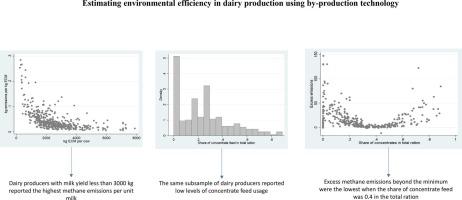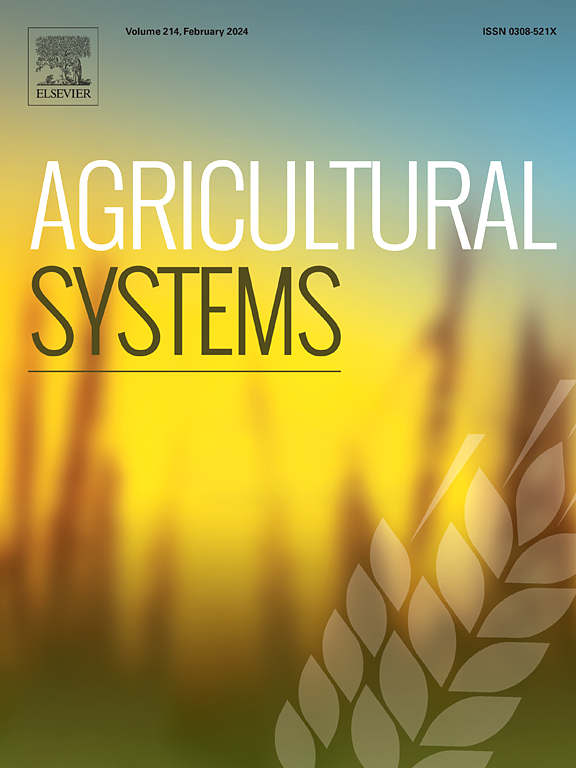Estimating environmental efficiency in dairy production using by-production technology
IF 6.1
1区 农林科学
Q1 AGRICULTURE, MULTIDISCIPLINARY
引用次数: 0
Abstract
CONTEXT
Milk production in developing countries is characterized by low per animal yield and disproportionately high GHG emissions. Specific policy recommendations are necessary to improve the technical as well as environmental efficiency of dairy production, especially for small farms. However, limited financial resources owned by producers lead to high transaction costs of introducing change. Both, concentrate feed and roughage, that is dry nonconcentrates, are used in milk production. These inputs are also responsible for methane emissions through enteric fermentation. Especially cellulose-rich dry nonconcentrates are fueling methane emissions through enteric fermentation.
OBJECTIVE
Based on a systems approach including nutritional foundations, we estimated technical and environmental efficiency of dairy producers in the rural-urban interface of Bengaluru, India. We studied the shortfall in milk production and excess methane emissions for each dairy farm and their drivers.
METHODS
Using panel data of 245 dairy producers, we fitted the production frontier for estimating technical efficiency and treated the emission generating technology like a cost frontier for estimating environmental efficiency – using stochastic frontier analysis. This study uses the parametric application of by-production technology.
RESULTS AND CONCLUSIONS
High heterogeneity in enteric methane emissions at low levels of milk yield are related to excessive feeding of dry nonconcentrates by producers. Plotting excess methane emissions beyond the fitted frontier against the share of concentrates in the total feed ration indicated that a global low is reached at around 40 % concentrates in the cows' diet. Therefore, farmers should intensify production by increasing the share of concentrate feed in dairy cattle rations to this level. Also, we suggest promoting the construction of cattle sheds and increasing the proportion of cows with high milk production potential in the herd to improve environmental efficiency.
SIGNIFICANCE
With economic growth as well as an increase in population, the demand for dairy products in developing countries will increase and lead to an expansion of dairy production. GHG emissions such as methane from livestock rearing will have to be managed and adequate policy measures will have to be implemented to reduce their share in global GHG emissions. By integrating animal nutrition perspectives and environmental efficiency from economics into a systems approach, we propose specific recommendations for public policy in terms of the target group of producers and the correct proportion of concentrate feed and dry nonconcentrates in total feed rations for dairy cattle in India. This will ensure that producers reach their full potential in milk production and environmental sustainability.

利用副产品技术估算乳制品生产的环境效率
发展中国家牛奶生产的特点是单产低和不成比例的高温室气体排放。有必要提出具体的政策建议,以提高乳制品生产的技术和环境效率,特别是对小型农场而言。然而,生产者拥有的有限的财务资源导致引入变革的交易成本很高。精饲料和粗饲料(即干的非精料)都用于牛奶生产。这些输入物还通过肠道发酵产生甲烷排放。尤其是富含纤维素的干非浓缩物,通过肠道发酵加速了甲烷的排放。目的:基于包括营养基础在内的系统方法,我们估计了印度班加罗尔城乡结合部乳制品生产商的技术和环境效率。我们研究了每个奶牛场及其司机的牛奶产量不足和过量甲烷排放。方法利用245家乳制品生产企业的面板数据,采用随机前沿分析方法,拟合生产前沿用于估算技术效率,并将排放产生技术视为成本前沿用于估算环境效率。本研究采用副产技术的参数化应用。结果与结论产奶量低时肠道甲烷排放的异质性与生产者过度饲喂干非精料有关。绘制超出拟合边界的过量甲烷排放量与精料在总饲料日粮中的比例表明,全球最低水平约为奶牛日粮中精料的40%。因此,农民应通过将精料饲料在奶牛口粮中的比例提高到这一水平来加强生产。同时,建议推进牛棚建设,增加高产潜力奶牛在畜群中的比例,提高环境效率。随着经济的增长以及人口的增加,发展中国家对乳制品的需求将增加,并导致乳制品生产的扩大。必须对牲畜饲养产生的甲烷等温室气体排放进行管理,并必须实施适当的政策措施,以减少它们在全球温室气体排放中的份额。通过将动物营养观点和环境效率从经济学整合到一个系统方法中,我们就生产者的目标群体和印度奶牛总饲料口粮中精料饲料和干非精料饲料的正确比例提出了具体的公共政策建议。这将确保生产者在牛奶生产和环境可持续性方面充分发挥潜力。
本文章由计算机程序翻译,如有差异,请以英文原文为准。
求助全文
约1分钟内获得全文
求助全文
来源期刊

Agricultural Systems
农林科学-农业综合
CiteScore
13.30
自引率
7.60%
发文量
174
审稿时长
30 days
期刊介绍:
Agricultural Systems is an international journal that deals with interactions - among the components of agricultural systems, among hierarchical levels of agricultural systems, between agricultural and other land use systems, and between agricultural systems and their natural, social and economic environments.
The scope includes the development and application of systems analysis methodologies in the following areas:
Systems approaches in the sustainable intensification of agriculture; pathways for sustainable intensification; crop-livestock integration; farm-level resource allocation; quantification of benefits and trade-offs at farm to landscape levels; integrative, participatory and dynamic modelling approaches for qualitative and quantitative assessments of agricultural systems and decision making;
The interactions between agricultural and non-agricultural landscapes; the multiple services of agricultural systems; food security and the environment;
Global change and adaptation science; transformational adaptations as driven by changes in climate, policy, values and attitudes influencing the design of farming systems;
Development and application of farming systems design tools and methods for impact, scenario and case study analysis; managing the complexities of dynamic agricultural systems; innovation systems and multi stakeholder arrangements that support or promote change and (or) inform policy decisions.
 求助内容:
求助内容: 应助结果提醒方式:
应助结果提醒方式:


